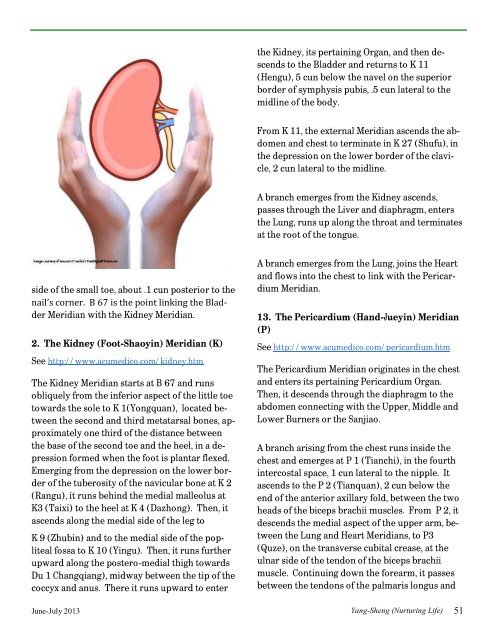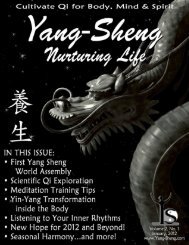to download Yang Sheng as a PDF
to download Yang Sheng as a PDF
to download Yang Sheng as a PDF
- No tags were found...
Create successful ePaper yourself
Turn your PDF publications into a flip-book with our unique Google optimized e-Paper software.
the Kidney, its pertaining Organ, and then descends<strong>to</strong> the Bladder and returns <strong>to</strong> K 11(Hengu), 5 cun below the navel on the superiorborder of symphysis pubis, .5 cun lateral <strong>to</strong> themidline of the body.From K 11, the external Meridian <strong>as</strong>cends the abdomenand chest <strong>to</strong> terminate in K 27 (Shufu), inthe depression on the lower border of the clavicle,2 cun lateral <strong>to</strong> the midline.A branch emerges from the Kidney <strong>as</strong>cends,p<strong>as</strong>ses through the Liver and diaphragm, entersthe Lung, runs up along the throat and terminatesat the root of the <strong>to</strong>ngue.side of the small <strong>to</strong>e, about .1 cun posterior <strong>to</strong> thenail’s corner. B 67 is the point linking the BladderMeridian with the Kidney Meridian.2. The Kidney (Foot-Shaoyin) Meridian (K)See http://www.acumedico.com/kidney.htmThe Kidney Meridian starts at B 67 and runsobliquely from the inferior <strong>as</strong>pect of the little <strong>to</strong>e<strong>to</strong>wards the sole <strong>to</strong> K 1(Yongquan), located betweenthe second and third metatarsal bones, approximatelyone third of the distance betweenthe b<strong>as</strong>e of the second <strong>to</strong>e and the heel, in a depressionformed when the foot is plantar flexed.Emerging from the depression on the lower borderof the tuberosity of the navicular bone at K 2(Rangu), it runs behind the medial malleolus atK3 (Taixi) <strong>to</strong> the heel at K 4 (Dazhong). Then, it<strong>as</strong>cends along the medial side of the leg <strong>to</strong>K 9 (Zhubin) and <strong>to</strong> the medial side of the poplitealfossa <strong>to</strong> K 10 (Yingu). Then, it runs furtherupward along the postero-medial thigh <strong>to</strong>wardsDu 1 Changqiang), midway between the tip of thecoccyx and anus. There it runs upward <strong>to</strong> enterA branch emerges from the Lung, joins the Heartand flows in<strong>to</strong> the chest <strong>to</strong> link with the PericardiumMeridian.13. The Pericardium (Hand-Jueyin) Meridian(P)See http://www.acumedico.com/pericardium.htmThe Pericardium Meridian originates in the chestand enters its pertaining Pericardium Organ.Then, it descends through the diaphragm <strong>to</strong> theabdomen connecting with the Upper, Middle andLower Burners or the Sanjiao.A branch arising from the chest runs inside thechest and emerges at P 1 (Tianchi), in the fourthintercostal space, 1 cun lateral <strong>to</strong> the nipple. It<strong>as</strong>cends <strong>to</strong> the P 2 (Tianquan), 2 cun below theend of the anterior axillary fold, between the twoheads of the biceps brachii muscles. From P 2, itdescends the medial <strong>as</strong>pect of the upper arm, betweenthe Lung and Heart Meridians, <strong>to</strong> P3(Quze), on the transverse cubital cre<strong>as</strong>e, at theulnar side of the tendon of the biceps brachiimuscle. Continuing down the forearm, it p<strong>as</strong>sesbetween the tendons of the palmaris longus andJune-July 2013 <strong>Yang</strong>-<strong>Sheng</strong> (Nurturing Life) 51













